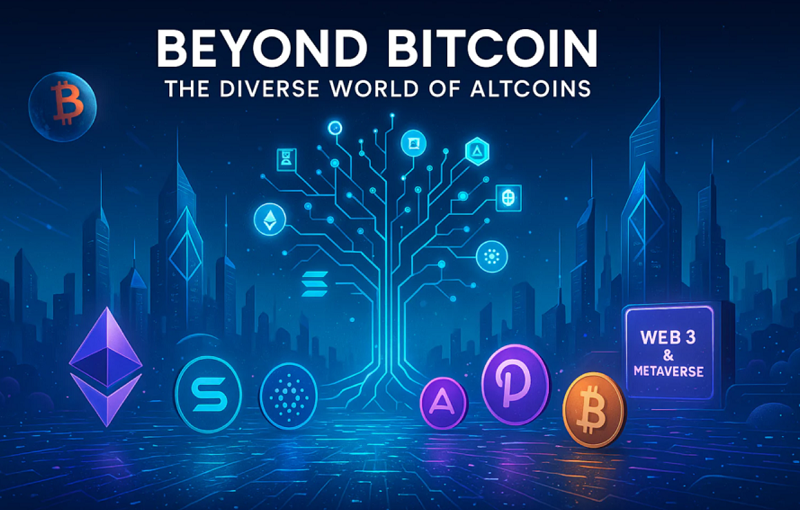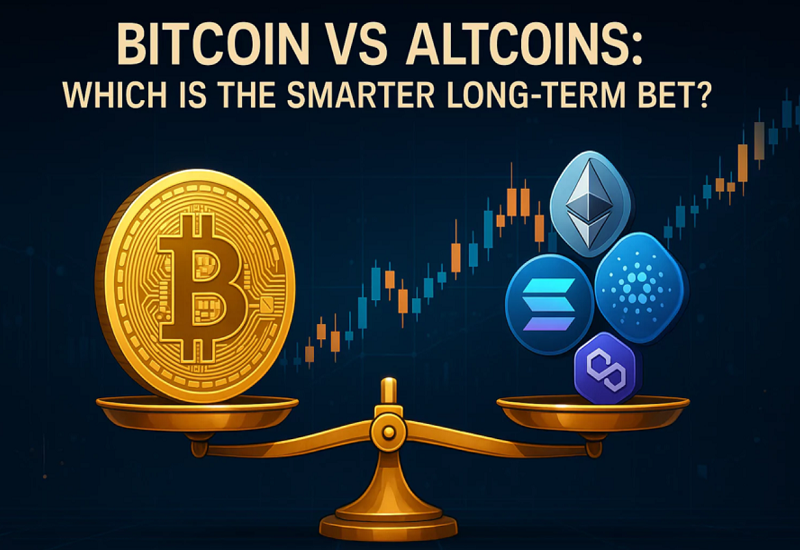The cryptocurrency world has evolved far beyond the early days of Bitcoin. Today, we are faced with thousands of coins and tokens, each claiming to bring something new to the table. But despite all the innovation and hype surrounding altcoins, Bitcoin continues to hold the lion’s share of market attention, liquidity, and institutional confidence.
This brings us to a critical question that every serious crypto investor must ask: Should you invest primarily in Bitcoin, or is there a smarter long-term opportunity in altcoins?
In this comprehensive guide, we will dissect both sides of the argument. You will get a deep dive into Bitcoin’s historical strength, the explosive potential of altcoins, and the investment factors that matter most in a rapidly shifting digital economy. Our goal is to help you make a rational, informed, and forward-looking decision.
Bitcoin: The Original, Battle-Tested Cryptocurrency

The Backstory and Purpose of Bitcoin
Bitcoin was introduced in 2009 by the pseudonymous Satoshi Nakamoto in direct response to the 2008 financial crisis. Its creation was intended to disrupt centralized financial systems and offer a decentralized peer-to-peer currency outside the control of governments and banks.
At its core, Bitcoin is not just a digital asset. It is a monetary network with embedded economic principles such as scarcity, decentralization, and censorship resistance.
Why Bitcoin Remains Relevant in 2025
There are many reasons Bitcoin continues to dominate headlines and institutional portfolios:
- Finite Supply and Scarcity: Bitcoin has a hard cap of 21 million coins. This scarcity is fundamental to its design and mirrors the finite nature of resources like gold. As more investors enter the space, this fixed supply increases Bitcoin’s perceived value over time.
- Network Security and Trust: Bitcoin’s blockchain is secured by the largest and most decentralized Proof of Work system in the world. This gives it the strongest track record for immutability and censorship resistance. It has never been hacked.
- Global Liquidity and Adoption: Bitcoin is traded on every major exchange, supported by traditional finance products like ETFs, and accepted as legal tender in several countries. It is deeply entrenched in both institutional and retail investment strategies.
Bitcoin’s Strengths and Limitations
Strengths:
- Highly secure and decentralized architecture
- Globally recognized as a store of value
- Deep institutional interest and regulatory clarity
- Proven ability to withstand multiple bear markets
Limitations:
- Limited transaction throughput and scalability
- Primarily a value storage asset with minimal smart contract functionality
- Slower innovation due to conservative upgrade cycles
Altcoins: Innovation-Driven, High-Risk, High-Reward Assets

What Exactly Are Altcoins?
Altcoins, short for “alternative coins,” include every cryptocurrency that is not Bitcoin. These projects span a vast range of technologies and use cases. Some focus on decentralized finance. Others are built around gaming, artificial intelligence, or even tokenizing real-world assets.
Altcoins are often viewed as experimental or growth-stage technologies compared to Bitcoin’s conservative, monetary-first approach.
Categories and Examples of Altcoins
- Smart Contract Platforms: These blockchains allow developers to build decentralized applications. Examples include Ethereum, Solana, Cardano, and Avalanche.
- DeFi Tokens: These are governance or utility tokens within decentralized finance ecosystems. Examples include Uniswap (UNI), Aave (AAVE), and Compound (COMP).
- Stablecoins: These tokens are designed to maintain a 1:1 peg with fiat currencies like the US Dollar. Examples include USDC, USDT, and DAI.
- Meme and Community Coins: These coins often start as jokes or viral community movements. Dogecoin and Shiba Inu are well-known examples.
- Emerging Narratives: This category includes tokens focused on artificial intelligence, data storage, gaming, and real-world asset tokenization. Examples include Render (RNDR), The Graph (GRT), and Chainlink (LINK).
Altcoins: Strengths and Pitfalls
Strengths:
- Rapid innovation and diverse real-world applications
- Potential for outsized returns, especially in early phases
- Greater flexibility in terms of governance and upgrades
- More utility across sectors like DeFi, NFTs, and gaming
Weaknesses:
- Higher rate of failure and obsolescence
- Lower levels of security and decentralization
- Vulnerability to market sentiment and speculation
- Inconsistent regulation and compliance risk
Bitcoin vs Altcoins: Full Comparison Across Key Metrics
| Investment Factor | Bitcoin | Altcoins |
| Market Capitalization | The highest among all cryptocurrencies | Varies widely by project, but generally lower than Bitcoin |
| Network Security | Extremely high due to global Proof of Work mining | Varies by consensus model, often less secure |
| Use Case | Primarily a store of value and transfer of wealth | Broad use cases including DeFi, NFTs, data, gaming, and more |
| Regulatory Clarity | Increasingly accepted as a commodity or asset | Many face unclear or changing legal status |
| Institutional Adoption | Strong presence through ETFs and public companies | Select altcoins have gained traction but remain mostly retail-driven |
| Volatility | Lower relative to most altcoins | Typically more volatile, with bigger price swings |
| Return on Investment | Historically steady and positive over long periods | High upside potential, but often short-lived or risky |
| Liquidity and Access | Listed on all major exchanges with deep liquidity | Liquidity varies significantly between projects |
| Innovation Speed | Deliberately slow and cautious | Rapid, experimental, often community-driven |
What to Consider for Long-Term Investment Decisions
Your Risk Profile Matters
If you are a risk-averse investor looking for stability and long-term value appreciation, Bitcoin is more aligned with your goals. Its historic resilience and increasing institutional validation make it a conservative crypto bet.
If, however, you have a higher risk tolerance and are comfortable with volatility and uncertainty, then altcoins may offer the kind of explosive growth opportunities that can outperform Bitcoin, if you pick winners carefully.
Time Horizon and Patience
Bitcoin typically rewards investors who hold over long timeframes, regardless of short-term fluctuations. Altcoins, on the other hand, tend to move in hype cycles. Many of them experience rapid price surges followed by deep corrections. Understanding where you are in the market cycle is crucial.
Diversification Is Often the Smartest Strategy
A combined approach may be more effective than choosing one over the other. For example:
- A portfolio consisting of 60 percent Bitcoin, 30 percent Ethereum or other large-cap altcoins, and 10 percent emerging projects allows for both security and upside exposure.
- Rebalancing periodically based on market trends and macroeconomic shifts can help manage risk.
Regulatory Landscape Can Shift the Game
Bitcoin has achieved regulatory acceptance in several jurisdictions, including the United States, where it is often treated as a commodity. Altcoins face more scrutiny, especially in the United States, where the Securities and Exchange Commission has challenged their status. Regulatory developments can significantly impact altcoin valuations.
Bitcoin and Altcoin Performance: Historical Perspective
Bitcoin’s Long-Term Track Record
Since its inception, Bitcoin has outperformed nearly every other asset class. It has gone through multiple boom-and-bust cycles, each time recovering to new all-time highs. Its deflationary model, driven by halving cycles, creates a recurring supply shock that tends to fuel bull markets.
Ethereum and Other Altcoin Success Stories
Ethereum has evolved from a developer’s experiment into a powerhouse for decentralized finance, NFTs, and Layer 2 scaling. Solana has shown that high-speed blockchain applications are possible, though it has also battled reliability concerns. Altcoins like Cardano, Polkadot, and Avalanche have carved out strong developer ecosystems and communities.
Survivorship Bias in the Altcoin Market
For every successful altcoin, there are hundreds of others that failed to gain traction or were outright scams. Projects like Terra Luna, SafeMoon, and BitConnect serve as reminders that high returns come with high risk, and not every coin with a community and a roadmap survives.
Real-World Investor Examples
Bitcoin: The Power of Holding Through Cycles
Retail investors who bought and held Bitcoin from 2015 to 2025 saw tremendous compounding returns. MicroStrategy’s corporate strategy of accumulating Bitcoin is now viewed as a bold, visionary move that paid off handsomely.
Altcoin Successes and Pitfalls
Investors who participated in Ethereum’s 2015 ICO or accumulated Solana under one dollar made massive returns. However, others who bought into hype-driven tokens during peak euphoria often suffered large losses when those tokens collapsed.
Timing, project quality, and conviction make all the difference when it comes to altcoin investing.
Insights From Industry Experts
- Michael Saylor (MicroStrategy): “Bitcoin is digital property. There’s no second best.”
- Raoul Pal (Real Vision): “Altcoins are tech startup investments. They’re high risk but potentially world-changing.”
- Cathie Wood (ARK Invest): “We believe Bitcoin is the most profound innovation in monetary history.”
Institutional commentary continues to differentiate Bitcoin as a macro asset and altcoins as emerging technologies or application platforms.
Bitcoin vs. Altcoins: Which Is the Smarter Long-Term Bet?
Bitcoin offers unmatched security, liquidity, and institutional confidence. It is the anchor of the crypto ecosystem and serves as a reliable store of value.
Altcoins, by contrast, are highly speculative but provide access to innovation and exponential growth potential. However, the risk of loss is higher, and investor due diligence is essential.
The smarter bet is not necessarily Bitcoin or altcoins. It is having a smart strategy that incorporates both.
- If your goal is wealth preservation and stability, prioritize Bitcoin.
- If you seek growth and can stomach volatility, allocate a portion to high-conviction altcoins.
- If you want both, create a diversified portfolio that aligns with your financial goals and risk tolerance.
Strategic Takeaways for Investors
- Begin with a strong foundation in Bitcoin before exploring the altcoin market.
- Research each altcoin project thoroughly. Technology, team, tokenomics, and use case all matter.
- Use dollar-cost averaging to build positions over time and reduce timing risk.
- Rebalance your portfolio regularly to reflect market conditions and macro trends.
- Stay informed. The crypto market evolves rapidly, and staying updated gives you an edge.
Conclusion
The debate between Bitcoin and altcoins will likely continue for years. But the smartest investors are not caught up in choosing sides. They are focused on building strategies that reflect both safety and opportunity.
Bitcoin remains the backbone of digital assets. Altcoins represent the bleeding edge of innovation.
Understanding the role of each will help you invest not just with confidence, but with conviction.

